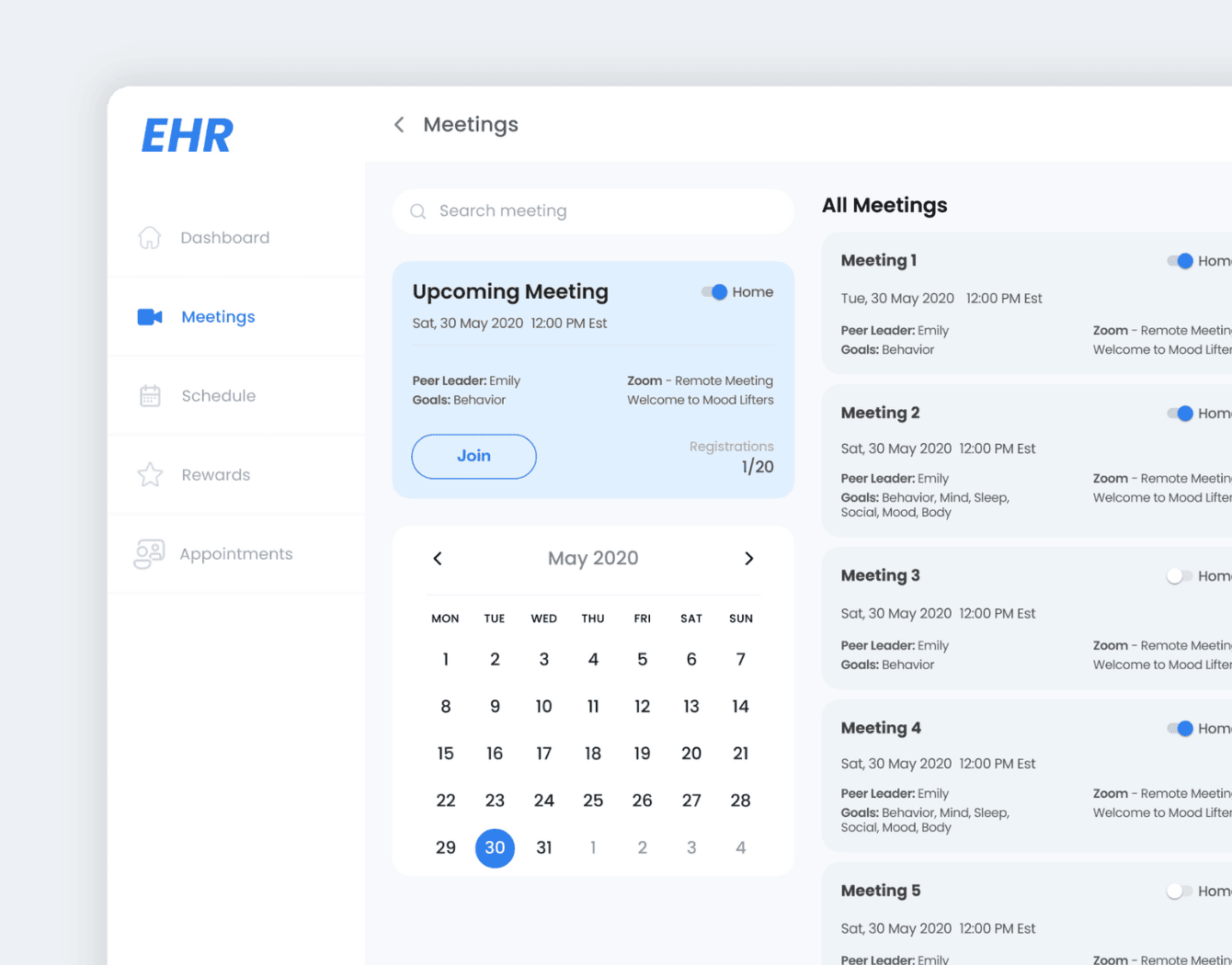As telehealth services rapidly evolve and gain popularity among users, healthcare providers take steps to harmonize telehealth solutions with existing systems. Given that many clinical workflows already rely on certified EHR platforms, telehealth with EHR integration is a must for many organizations to simplify virtual care and keep all data within one system.
Based on the most conservative estimate, 86.6% of physicians in small practices will use electronic health records in 2024. This means that you should consider integrating telehealth and EHR whenever you adopt a new telehealth tool.
This article overviews the top integration options, the steps you need to take, and other crucial aspects to mind.
What Is Telehealth EHR Integration, and Is It Mandatory?
Telehealth EHR integration involves connecting telemedicine platforms with electronic health record (EHR) systems to facilitate patient information exchange. This integration allows healthcare providers to access patient data during telehealth consultations. It streamlines workflows by eliminating manual data entry and enhances patient care coordination thanks to health information centralized in one system.
Telehealth EHR integration is not mandatory but is becoming a standard practice for modern healthcare delivery due to the many tangible benefits listed below.
Read All You Need to Know About EMR/EHR Implementation Process
Benefits of EHR + Telemedicine Practice Management
The integration of telehealth platforms into a hospital’s existing EHR system enhances the benefits of telemedicine and brings other advantages, as listed below.
Increased Efficiency of Healthcare Operations
The integration of EHR software with telemedicine enhances the efficiency of healthcare operations by eliminating the need for manual data transfer. It ensures instant access to patient information during virtual consultations and reduces administrative burdens. Streamlining data transfer also enhances the accuracy and timeliness of patient care.
Seamless Clinical Workflow
During virtual visits, patient data is easily accessible from an EHR system and well-organized, which ensures uninterrupted and informed consultations. Besides, streamlined documentation results in more accurate patient records and billing.
Improved Patient Care
Interoperable EHR systems ensure accurate patient information, enabling informed decisions and personalized treatment. The integration of telehealth further extends these capabilities, allowing patients to benefit from convenient, barrier-free consultations and active involvement in their care. Recent studies show that telehealth leads to reductions in condition-related hospitalizations and enhancement in patient satisfaction across every medical specialty.
Automatic and Error-Free Data Entry
Telemedicine EHR integration eliminates the need for duplicate data entry and reduces medical errors during data transfer. By automating the exchange of patient information between systems, the integration process ensures that data is accurate and up-to-date across all platforms.
Optimized Expenses
EHR and telemedicine integration significantly reduces costs for patients and the healthcare system. Patients save on travel and can easily switch providers, choosing anyone remotely, while healthcare organizations reduce redundant tests and operational costs.
Enhanced Patient Satisfaction
Telemedicine EHR integration boosts patient satisfaction by combining efficient workflow management with accessible care. Patients appreciate seamless access to medical records during consultations and increased involvement in their treatment. The positive impact of telemedicine care on patient satisfaction is particularly evident in rural areas, with 80% of rural areas classified as medically underserved. For many local residents, a telehealth visit is the only option for accessing professional healthcare services.
Data and Evidence-Based Prescriptions
Providers won’t have to rely on patients for their clinical history or use the EHR system simultaneously with telemedicine tools. Integration helps them write evidence-based prescriptions and enhances patient outcomes.
Types of EHR Integration
Integrating EHR with telemedicine requires a seamless data exchange between these systems. You will choose between bi-directional and unidirectional data exchange depending on your needs.
| Bi-Directional Data Exchange | Unidirectional Data Exchange |
| Health information is transferable in both directions between EHR and telemedicine systems. | Health information is transferable in one direction, from EHR to telemedicine. |
| Benefits: – Error-free transfer of patient data. – Facilitates sharing of patient history and other required information. – Reduces efforts needed for data management. – Enables broader data sharing without errors. | Benefits: – Simplifies the data transfer process. – Minimizes the risk of data conflicts and errors – with a straightforward transfer process. – Cost-effective solution. – Quick and efficient data transfer from EHR to telemedicine platforms. – Enhances security by reducing the number of data exchange points. |
The choice between bi-directional and unidirectional data exchange depends on the healthcare organization’s needs. If you need advice on which method is better for your case, contact Empeek for consulting.
Top EHR and Telemedicine Solutions to Integrate
As medical professionals and healthcare institutions strive to meet the growing demand for virtual care, it is essential to select the best EHR and telemedicine solutions. We have analyzed the top industry listings and selected versatile EHR systems and telehealth apps you may consider integrating.
Let’s delve into the top EHR and telemedicine solutions available today and examine their key features.
Most Popular EHR Choices
Choosing an EHR requires a meticulous approach and professional EHR engineering consulting since it’s a core platform your medical practice will rely on. You must consider interoperability, regulatory compliance, the vendor’s reputation and tech support system, potential liability risks related to using EHR software, and functionality, of course.
The options we provide in our listing have been on the market for decades and are the top choice for many healthcare providers. These are reliable providers, so you can focus on their strengths, weaknesses, and unique features instead of worrying about software quality or legal issues.
Epic
Epic put a lot of emphasis on interoperability for seamless data exchange between different healthcare entities. It prioritizes patient engagement, offering tools and functionalities to enhance patient-provider interaction and improve health outcomes.
Oracle Health
Oracle Health has robust data analytics capabilities and population health management tools, making it a popular choice among healthcare providers. It’s a patient-centric EHR with computer-assisted coding and referral management features.
Meditech
Meditech is favored by smaller hospitals and community health systems for its affordability and user-friendly interface. It offers strong clinical and financial management capabilities. Its intuitive design and cost-effectiveness make it a practical choice for organizations seeking efficient EHR solutions without compromising functionality.
Allscripts
Allscripts stands out for its versatile and scalable solutions that cater to the needs of both large and small healthcare providers. With robust interoperability features, Allscripts facilitates data sharing and collaboration among healthcare professionals. Its suite of tools empowers organizations to manage patient data and improve clinical workflows effectively.
NextGen Healthcare
NextGen Healthcare offers tailored solutions for practice management and clinical care. With a strong emphasis on improving clinical outcomes and operational efficiency, NextGen Healthcare enables healthcare providers to deliver high-quality care while optimizing their workflows.
Athenahealth
Athenahealth is a cloud-based EHR solution with user-friendly interfaces and real-time updates. By focusing on reducing administrative burdens and enhancing patient care coordination, Athenahealth helps healthcare organizations streamline their operations and deliver more efficient care. Its cloud-based platform ensures accessibility and scalability, making it suitable for organizations of all sizes.
Top Telemedicine Apps to Connect
When choosing a telemedicine app, you have more flexibility than with an EHR system. In 2023, there were 1,306 telehealth businesses in 2023 in the US only, so the selection is truly rich.
Data privacy, integration capabilities, and functionality are the main aspects to consider. You must ensure telehealth integration won’t harm the security of personal health information and that the exchange of telehealth data with the selected EHR system will happen smoothly. Below, we offer some of the most popular providers that can enrich your digital medical practice with online video calls, messaging, mental health features, and other capabilities.
Amwell
Amwell offers telehealth services that include urgent care, behavioral health, and chronic care management. It integrates with EHR systems to provide 24/7 patient access, which includes documentation features that automatically update patient records with consultation notes, prescriptions, and follow-up plans. Amwell’s workflow integration reduces the need for manual entry by integrating telehealth visits directly into existing EHR workflows.
Teladoc
Teladoc provides 24/7 access to a wide range of medical specialists. Its real-time data synchronization ensures that patient health data is consistently updated between telehealth sessions and the EHR, maintaining medical records up-to-date. Teladoc’s integration capabilities allow you to incorporate personalized care plans and follow-up schedules directly into the EHR.
Zoom for Healthcare
Zoom for Healthcare is a HIPAA-compliant version of the popular video conferencing tool designed to provide secure telehealth services. Zoom for Healthcare integration allows healthcare providers to access and update patient records during consultations and offers customizable workflows to fit existing EHR processes, such as virtual waiting rooms and appointment scheduling.
VSee
VSee is a versatile telemedicine platform that supports video consultations and secure messaging. VSee offers extensive customization options to fit specific EHR workflows and requirements, enhancing the flexibility and usability of telehealth services within different healthcare settings.
MDLIVE
MDLive integration with EHR systems supports behavioral health services, incorporating mental health care into the overall patient record for a holistic view of patient health. Its prescription management features synchronize prescription data with the EHR, ensuring up-to-date medication records. MDLIVE provides HIPAA-compliant communication channels for confidential and efficient patient-provider interactions.
Your next read: Secure Messaging Software in Healthcare – Features, Benefits and Technologies of HIPAA-compliant Messaging Apps
Doctor on Demand
Doctor on Demand provides a wide range of telehealth services, including urgent care and mental health. Its documentation features automatically update patient records with consultation notes and follow-up care plans that enhance the accuracy and completeness of medical records. The platform’s integration improves care coordination by incorporating telehealth visits and follow-ups into the EHR system.
Even though many providers opt for these widely recognized EHR systems and telehealth apps, to gain a competitive advantage, you must design a custom solution tailored to your organizational needs.
Empeek provides telehealth software development services and EHR/EMR development to help you build a unique system for your organization. The custom solution will be more cost-efficient, convenient, and better adapted to your workflows.
10 Steps of Telehealth EHR Integration
To successfully integrate two systems, you must adopt a structured approach. To help you navigate this process effectively, we have outlined the 10 critical steps of telehealth EHR integration we follow at Empeek.
Step 1. Vendor Selection
The first step involves selecting vendors that provide telehealth solutions and/or EHR systems, especially if your practice does not yet have an EHR system. Conduct thorough research to evaluate different vendors based on their features, compatibility, and user reviews. Consider factors such as integration capabilities, security measures, customer support, and cost. Engaging stakeholders in this decision-making process ensures that the chosen systems meet the specific needs of your healthcare practice.
Step 2: Product Assessment
Before starting telehealth and EHR integration, conduct a detailed product assessment. Evaluate your existing EHR system for compatibility with telehealth tools or, if you do not have an EHR system yet, assess both components to ensure their compatibility. Overall, you should evaluate the following:
- Interoperability standards and data exchange protocols
- Functional compatibility
- Security and compliance
- User experience and interface
- Customization and scalability
This step is essential to identifying potential integration challenges and ensuring that the chosen solutions will meet your practice’s needs.
Step 3: Protocol & Standard Validation
Selecting the appropriate integration standards and protocols is crucial for seamless data exchange between telehealth and the EHR system. Consider factors such as interoperability requirements, data exchange formats, and industry standards. Common integration standards include FHIR (Fast Healthcare Interoperability Resources), DICOM (Digital Imaging and Communications in Medicine), and HL7 (Health Level Seven). Choosing the right standards ensures compatibility and facilitates efficient communication between systems.
Step 4: Data & System Preparation
Once you check the compatibility, the next step is to prepare telehealth systems and EHR for integration. Organize medical data to ensure it is accurate, consistent, and formatted appropriately for integration with the EHR system. This may involve cleaning up existing data, standardizing data formats, and ensuring data quality. Adequate preparation of data and systems is essential to facilitate smooth integration and minimize disruptions to the workflow.
Step 5: API & Interface Creation
Developing interfaces and APIs is essential to transfer data between telehealth tools and the EHR system. APIs serve as communication channels through which systems exchange data. Create interfaces that enable secure and efficient data transfer, considering factors such as :
- Data mapping: This involves defining how data fields in a telehealth solution correspond to fields in the EHR system, handling different data formats, and maintaining data integrity. For example, you must accurately map patient demographic information, medical history, and treatment plans to corresponding fields in the EHR.
- Authentication: This includes implementing multi-factor authentication (MFA), OAuth (Open Authorization), and other industry-standard protocols to ensure that only authorized personnel can access sensitive patient information. Proper authentication prevents unauthorized access and protects patient privacy.
- Error handling: Efficient data transfer must include strategies to identify, log, and resolve issues that may arise during data exchange. You need to set up automated alerts for data mismatches, missing information, or connectivity problems and develop protocols for manual intervention.
Step 6: Data Security Assurance
Prioritize data security and privacy throughout the integration process to safeguard sensitive patient information. Implement stringent security measures to protect data during transmission and storage. This includes encryption, access controls, audit trails, and compliance with regulatory requirements such as HIPAA. Data security assurance is paramount to maintaining patient trust and compliance with privacy regulations.
Step 7: System Integration
This step involves establishing secure communication channels and ensuring data flows seamlessly between the telehealth solution and the EHR. Integration should enable functionalities such as SSO, automatic updates of patient records with telehealth visit details, synchronized scheduling, and consolidated billing processes.
Step 8: System Testing
Thoroughly test the integrated system to identify and address potential hitches or glitches before deployment. Conduct comprehensive testing to validate data exchange functionality, system performance, and interoperability. This may involve unit, integration, and user acceptance testing to ensure the system meets quality standards and user requirements. System testing helps minimize the risk of issues post-deployment and ensures a smooth transition to the integrated environment.
Step 9: User Training
Teach medical personnel and patients how to effectively use the integrated EHR and telehealth software. Provide comprehensive training programs tailored to different user groups, covering system navigation, data entry, and security best practices. User training maximizes the benefits of integration, improves user adoption, and minimizes errors.
Step 10: Ongoing Oversight
Once the integrated system is up and running, ongoing support is necessary to monitor performance, identify areas for improvement, adapt to evolving needs and requirements, and address any issues that may arise. Implement regular audits and monitoring processes to ensure the proper work of the integrated environment. Regular checks and maintenance are essential to sustaining the long-term success of EHR integration and regulatory compliance.
This is a rough roadmap of telehealth EHR implementation that includes the main steps. It’s a complex process since you deal with personal health information and must ensure ultimate data security during the transfer and storage.
Yes, with a reliable software provider and decent preparation, the integration will happen smoothly and considerably expand your healthcare services.
Things to Consider for Successful Telehealth EHR Integration
Here are some key factors you should consider for successful telehealth EHR integration, seamless compatibility, and adherence to regulatory standards based on our experience.
Telehealth Compatibility with EHR Standards
Before integrating telehealth software, ensure it aligns with existing EHR standards and protocols to maintain data integrity and workflow continuity. Compatibility with EHR standards ensures seamless integration, promoting interoperability and smooth exchange of patient information.
HIPAA Compliance
Telehealth solutions integrated with EHR systems must adhere to HIPAA regulations to safeguard patient information. HIPAA compliance is essential to protect patient privacy and data security during telehealth interactions. Compliance includes secure data transmission, authentication measures, and access controls. Read more about HIPAA compliance guidelines and requirements in our blog post.
Experience of Integration Provider
Integration of EHR with telehealth requires a nuanced understanding of healthcare delivery, so collaborating with a third-party company may be more efficient. Make sure to choose a provider with real-world healthcare experience, well-established engineering processes, and years of experience in the healthcare software development market.
Holistic Approach
Implementing a telehealth platform requires a holistic view, considering every component from patient enrollment to discharge. You can build a truly comprehensive system only by understanding the daily interactions of doctors, nurses, administrators, and patients. We recommend interviewing the main user groups to understand what functionality they miss before integration.
Real Examples of Telehealth EHR Integration by Empeek
Empeek has integrated various telehealth functionalities with top EHR systems for multiple healthcare clients. Learn more about some of our projects below.
EHR for Behavioral Health
Empeek developed an EHR system for behavioral health and iOS and Android mobile apps where users can complete custom surveys, set up appointments with doctors, track weekly achievements, and receive rewards. The integration of telehealth functionalities within the EHR system enabled mental health professionals to provide remote consultations, monitor patient progress, and adjust treatment plans accordingly. The program complements traditional therapy in many medical practices across the US and is actively used by thousands of patients. Read the full case study.

Integration of Upvio Practice Management System and Elation EHR
GetHealr aimed to streamline operations for medical practices by integrating Upvio, a Practice Management (PM) system, with Elation, an EHR system. Empeek developed a real-time API integration to synchronize appointments between Upvio and Elation automatically.
Additionally, we enabled messaging integration between Upvio’s and Elation’s systems, mapped equivalent user roles for consistent access control, and integrated payment processing modules to enhance visibility into the organization’s financial health. Read the full case study.
Telehealth Integration Services With Empeek
At Empeek, we provide custom EHR and telemedicine platform development or integrate ready-made solutions depending on your business needs.
Our custom EHR and telemedicine solutions have tailored designs, outstanding usability, interoperability, and data security. For integration services, we always thoroughly analyze system requirements and capabilities to ensure the connected tools match and operate smoothly.
Schedule a consulting session to learn which telemedicine EHR implementation approach is more efficient for your organization.
Conclusion
This article outlines the steps for successful telehealth EHR integration, from selecting the right vendors and validating protocols to ensuring data security and providing user training. If you need help with going through this process, contact Empeek for EHR integration services.
A successful integration leads to more convenient patient care, improved patient outcomes, and an enhanced technology experience for providers throughout the health system. With a structured approach and the proper support, your organization can achieve a seamless and efficient telehealth EHR integration, ultimately advancing the quality and accessibility of healthcare services.








